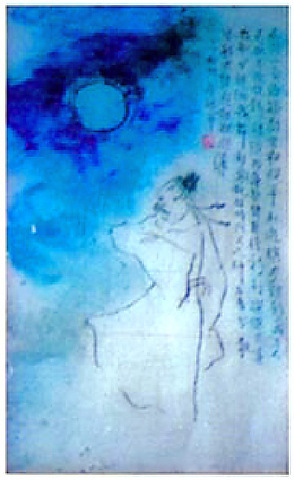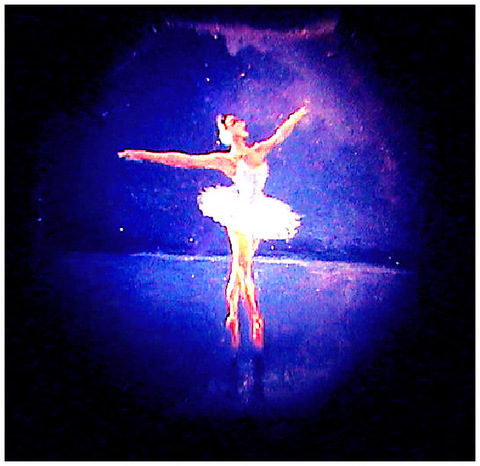I've never looked at Jin's micro-paintings or micro-carvings in person, and even if I had, I wouldn't have been able to see them -- not without a microscope. Even his biggest micro-painting, a group of portraits of the 42 US presidents on a single human hair, is less than 6mm long.
The Portraits of 42 American Presidents was completed last year in New York and holds the world record for most portraits in the smallest area. Somehow, Jin managed to give each president a vivid expression in a face with a diameter less than 0.4mm. Each face is distinct and recognizable.

Jin has created over 100 micro-paintings and carvings on different-colored hair, ivory and diamonds, and his works extend the traditional Chinese art of engraving and miniscule calligraphy.

PHOTOS COURTESY OF ARTIST:
In an e-mail interview, Jin explained that micro-painting has a long history in China and was done in pictographs on animal bones and tortoise shells. Jin called these Shang Dynasty inscriptions "the earliest mature writing" in China.
This writing, Jin said, was meant to evoke or explain the divine. As most people were illiterate, writing was of little help to the majority. In fact, it was the mystery of the inaccessible language that evoked the divine.
Today, micro-art creates hidden worlds similar to how carved pictographs created hidden worlds to populations of illiterates.
Jin has carved Tang Dynasty poems onto human hair, and his 1986 work Li Bai includes a Li Bai poem, beside a portrait of the poet in a white cloak under the moon -- all in a 3mm by 5.5mm area. Pine Trees in a Cloudy Valley (1985, 2x7.5mm), The Great Wall (1988, 3.5x6mm) and Flying Cloud (1986, 3x5.5mm) extend the Chinese landscape tradition, while Red Plum (1986, 3x6mm) is comparatively sparse and manages to contrast bright red petals on an ivory background through carving and painting.
Jin has extended traditional techniques of micro-carving and painting, too. He perfected a method called pomo in which minute amounts of ink are splashed onto the surface of ivory, usually about the size of a rice grain. Jin also uses more traditional tools, such as little brushes, inks and oils to paint.
Micro-painting is usually the medium he uses for his pop culture and Western-themed works, and he has also created micro-paintings of Asian and Middle Eastern heads of state. Elegant is a portrait on the width of a black hair and resembles Marilyn Monroe. Charlie Chaplain is about the same size and is painted on a white hair.
In the US and Europe, it's micro-painting, not micro-carving, that has found interest and applicability beyond pop culture icon renditions and pictures of president.
Micro-painting caught some attention during the West's modernist period, when American and European artists began to think of Asian art as something that could be applied to Western practice, not simply as something to gaze at with Orientalist thinking. Max Ernst's Micro-painting, at the Museum of Modern Art in New York is an example.
Micro-painting has also been practically applied in the area of making toys, trinkets, jewelry, models and game-pieces in the West, but China has been the hub of producing the items that are micro-painted and sent to the shelves of Western stores.
At the European company that produces Kinder Surprises -- tiny figures inside Easter eggs -- robots have taken over the painting of 23 million tiny figures, whose faces and details used to be painted by Chinese laborers. The robots are faster and paint with an accuracy within .01mm.
Micro-painting and micro-carving are still alive, well and centered in China, despite robotic competition. Jin separates his time between China and New York.
The world record for most characters in a micro-carving is held by Chinese artist?Xu Tonghai for, Selected Works of Mao Zedong, which includes 10,720,000 characters.

The canonical shot of an East Asian city is a night skyline studded with towering apartment and office buildings, bright with neon and plastic signage, a landscape of energy and modernity. Another classic image is the same city seen from above, in which identical apartment towers march across the city, spilling out over nearby geography, like stylized soldiers colonizing new territory in a board game. Densely populated dynamic conurbations of money, technological innovation and convenience, it is hard to see the cities of East Asia as what they truly are: necropolises. Why is this? The East Asian development model, with

June 16 to June 22 The following flyer appeared on the streets of Hsinchu on June 12, 1895: “Taipei has already fallen to the Japanese barbarians, who have brought great misery to our land and people. We heard that the Japanese occupiers will tax our gardens, our houses, our bodies, and even our chickens, dogs, cows and pigs. They wear their hair wild, carve their teeth, tattoo their foreheads, wear strange clothes and speak a strange language. How can we be ruled by such people?” Posted by civilian militia leader Wu Tang-hsing (吳湯興), it was a call to arms to retake

This is a deeply unsettling period in Taiwan. Uncertainties are everywhere while everyone waits for a small army of other shoes to drop on nearly every front. During challenging times, interesting political changes can happen, yet all three major political parties are beset with scandals, strife and self-inflicted wounds. As the ruling party, the Democratic Progressive Party (DPP) is held accountable for not only the challenges to the party, but also the nation. Taiwan is geopolitically and economically under threat. Domestically, the administration is under siege by the opposition-controlled legislature and growing discontent with what opponents characterize as arrogant, autocratic

When Lisa, 20, laces into her ultra-high heels for her shift at a strip club in Ukraine’s Kharkiv, she knows that aside from dancing, she will have to comfort traumatized soldiers. Since Russia’s 2022 invasion, exhausted troops are the main clientele of the Flash Dancers club in the center of the northeastern city, just 20 kilometers from Russian forces. For some customers, it provides an “escape” from the war, said Valerya Zavatska — a 25-year-old law graduate who runs the club with her mother, an ex-dancer. But many are not there just for the show. They “want to talk about what hurts,” she